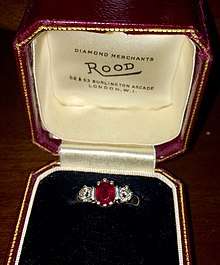Hancocks & Co
Hancocks & Co is a retail jeweller in London, founded on 1 January 1849 by Charles F. Hancock, a former partner of Storr and Mortimer. The first shop was opened at a corner of Bruton Street and New Bond Street, in London. It has moved several times since then. Hancocks has become notable for the manufacture of the Victoria Cross medals and also for the various Royal Warrants that it holds. It has been based in The Burlington Arcade in London since 1998.
History
Hancocks first gallery opened at a corner of Bruton Street and New Bond Street, in London in 1849. Hancocks subsequently moved in 1917 to Vigo Street, in 1970 to Burlington Gardens and 1998 to its current location at 52 & 53 Burlington Arcade. Hancocks has exhibited at several renowned exhibitions. The first exhibition that Hancocks attended was The Great Exhibition of 1851 at The Crystal Palace in London. It then participated in exhibitions in Paris in 1867 and Vienna in 1873 where Hancocks was awarded medals of excellence. Hancocks continues to participate in major exhibitions such as Grosvenor House, Maastricht and New York.[1]
In 1998, Hancocks acquired the business of S.J.Rood, diamond merchants and jewellery manufacturers. S.J.Rood were themselves awarded The Royal Warrant by Queen Mary (wife of King George V) in 1921 and are famous as the creators of the “For....” series of rings which were gifted to Queen Mary’s ladies-in-waiting on their marriage.[2] Hancocks currently occupy the former S.J.Root premises in Burlington Arcade.
Royal Appointments and Warrants
On 13 August 1849, after only eight months in business, Hancocks received the Royal Appointment of Queen Victoria. Many of the principal sovereigns of Europe also became regular patrons. There can be little doubt that the rapid expansion by Charles Hancock during the formative years of the Company led to Hancocks being entrusted with the design and production of the Victoria Cross on the inception of the award in 1856.[3] This medal is still made exclusively by Hancocks.[4]
In 1962 the Company was granted the Royal Warrant as Goldsmiths and Silversmiths to Queen Elizabeth, The Queen Mother.
S.J.Rood
S.J. Rood was established in London’s Burlington Arcade in 1873 and operated independently until they were acquired by Hancocks in 1998. Hancocks then took over the Rood premises in Burlington Arcade from where they remain trading today.
S.J.Rood was established by the Allen family who were diamond merchants in addition to their primary role as jewellery manufacturers and retailers to the rich and famous. From 1900 onwards the firm enjoyed great success with affluent Londoners and was awarded the Royal Warrant by Queen Mary, wife of George V, who reigned from 1910 until 1936 (and was then Queen Mother from 1936 until her death in 1952).
Queen Mary was an excellent customer and commissioned many pieces with S.J.Rood, both for herself and as gifts for others. Many of these pieces now sell for hefty premiums when they (all too rarely) come onto the open market.
S.J.Rood are perhaps most famously known as the manufacturers of the historic “For.....” series of rings which were created for Her Majesty Queen Mary and which were presented to her ladies-in-waiting on the occasion of their engagement. At least twelve rings are known to have been presented between 1918 and 1952. As Queen Mary was of German descent, her staff were a mixture of English and German ladies. As a consequence, many of the “For.....” rings are now located in either London or Bavaria.
The "For..." series of rings
In total, S.J.Rood made 12 rings in the "For...." series which are known to have been presented by Queen Mary to her ladies-in-waiting on the occasion of their engagement. These are:-
The ring "For Mary" - presented by Queen Mary in 1918. Currently on display in the Victoria and Albert Museum, London.

The ring "For Elizabeth" - presented by Queen Mary in 1921. Present whereabouts unknown.
The ring "For Anna" - presented by Queen Mary in 1925. Still owned by family descendants in Munich, Germany.
The ring "For Constantine" - presented by Queen Mary in 1927. Currently on display in the Victoria and Albert Museum, London.
The ring "For Victoria" - presented by Queen Mary in 1930. Present whereabouts unknown..
The ring "For Jana" - presented by Queen Mary in 1931. Sold at auction in 2018. Owner unknown.
The ring "For Alexandra" - presented by Queen Mary in 1934. Still owned by family descendants in London.
The ring "For Rosemary" - presented by Queen Mary in 1935. Sold at auction in 2014. New owner is based in US.
The ring "For Hannah" - presented by Queen Mary in 1937. Present whereabouts unknown.
The ring "For Sophia" - presented by Queen Mary in 1938. Still owned by family descendants in Munich, Germany.
The ring "For Maria" - presented by Queen Mary in 1946. Currently on display in the Victoria and Albert Museum, London.
The ring "For Stephania" - presented by Queen Mary in 1951. Sold at auction in 1993. Owner unknown.
Many of these rings now sell for hefty premiums when they (all too rarely) come onto the open market.
Current business
Hancocks, founded in 1849, is still family owned by Stephen and Janie Burton, and is one of London's oldest specialist dealers buying and selling rare and collectable jewels.[5] They are based in historical premises in The Burlington Arcade in London.
References
- "Hancocks of London History of VC". Hancocks of London events. Retrieved 2007-09-02.
- "S.J.ROOD - JEWELLERS". S.J.ROOD - JEWELLERS. Retrieved 2018-12-04.
- "Hancocks of London History of VC". Hancocks of London. Archived from the original on 2008-08-27. Retrieved 2007-09-02.
- Imperial War Museum. "The Victoria Cross". archive.iwm.org.uk. Archived from the original on 5 May 2013. Retrieved 5 April 2013.
- "Hancocks of London today". Hancocks of London. Archived from the original on 2006-02-16. Retrieved 2007-06-24.
External links
![]()